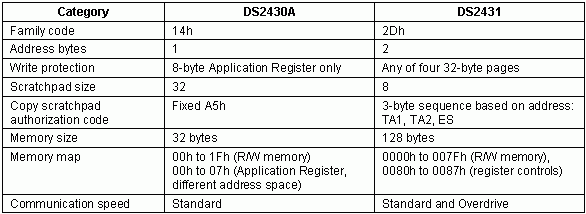Resource Library
Transition Guide: Replacing the DS2430A with the DS2431
Abstract
The DS2431 is an advanced 1-Wire® 1k-bit EEPROM replacement device for the older 256-bit DS2430A. This document discusses the differences in the command structure and memory map of the two devices. Particular attention is given to changes needed for applications that are transitioning to the larger DS2431 device. This application note also describes other important differences between the devices, specifically the DS2430A's Application Register and how to use the DS2431 in a write-protected, simulated EPROM mode.
Introduction
The DS2431 is an advanced 1-Wire 1k-bit EEPROM replacement device for the 256-bit DS2430A. There are several differences in the DS2431's command structure and memory map that require changes to applications transitioning to the newer, larger device. Each 1-Wire device, however, contains a unique 64-bit ROM identification number with 8 of the 64 bits representing the devices' common 'Family Code'. This 8-bit common code allows an application to recognize a different device, thus enabling a seamless transition between devices.
The DS2430A has a 64-bit Application Register that is write-once, and is in a separate memory space controlled with different commands. The DS2431 does not have the equivalent register. However, any of its four 32-byte pages can be individually write-protected or set into a simulated EPROM mode. EPROM mode allows a bit to be written from a logic one to a logic zero, but not back the other way. This technique can be useful in applications that require tracking of usage.
Both of these 1-Wire devices are offered in TO-92 and TSOC packages with the same pinout. Additionally, the DS2431 is available in SFN, TDFN, and chip-scale package (UCSP™). Table 1 summarizes the fundamental differences between the devices' command structure and memory map.
Table 1. Feature Comparison of the DS2430A and the DS2431

Memory Operations
The following Tables 2 through Table 5 detail common memory operations. The yellow highlighted sections show the differences between the two devices. Note that these operations use the 'Skip ROM' command to select the device. Alternatively, any of the ROM level commands and supporting data can be used. All data is read and written least significant bit first.
Table 2. Read Memory

Table 3. Write Scratchpad

Table 4. Read Scratchpad

Table 5. Copy Scratchpad

The DS2430A is no longer recommended for new designs.